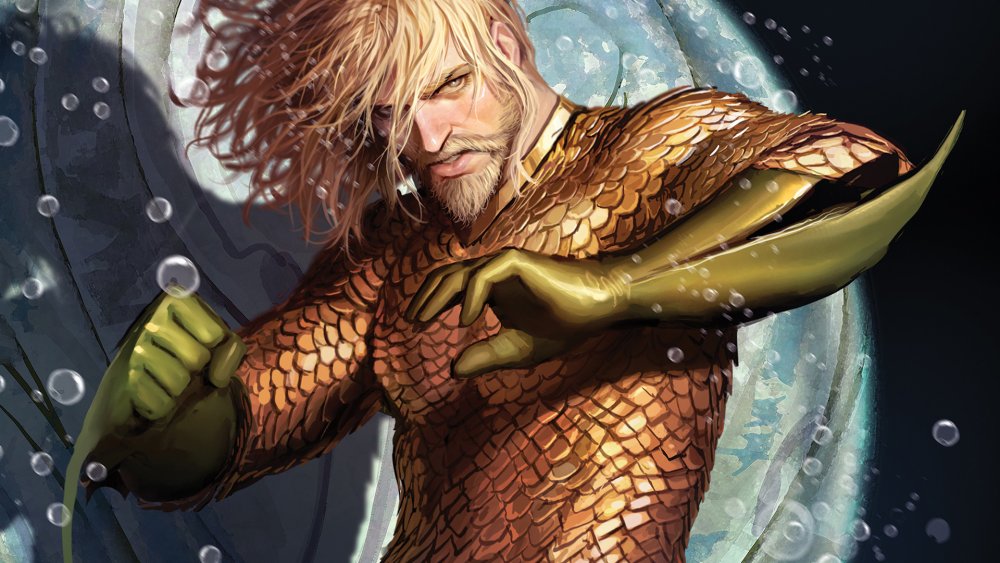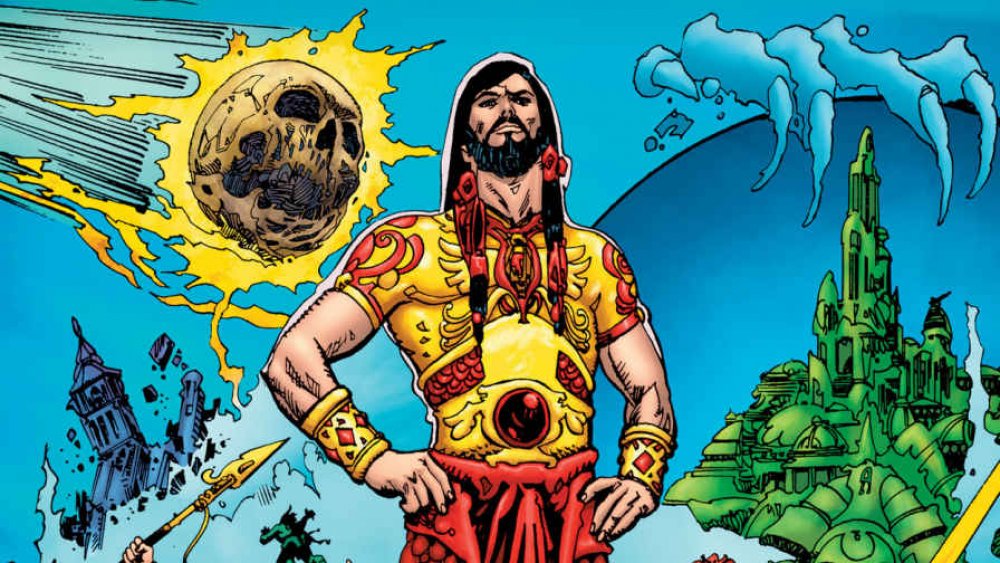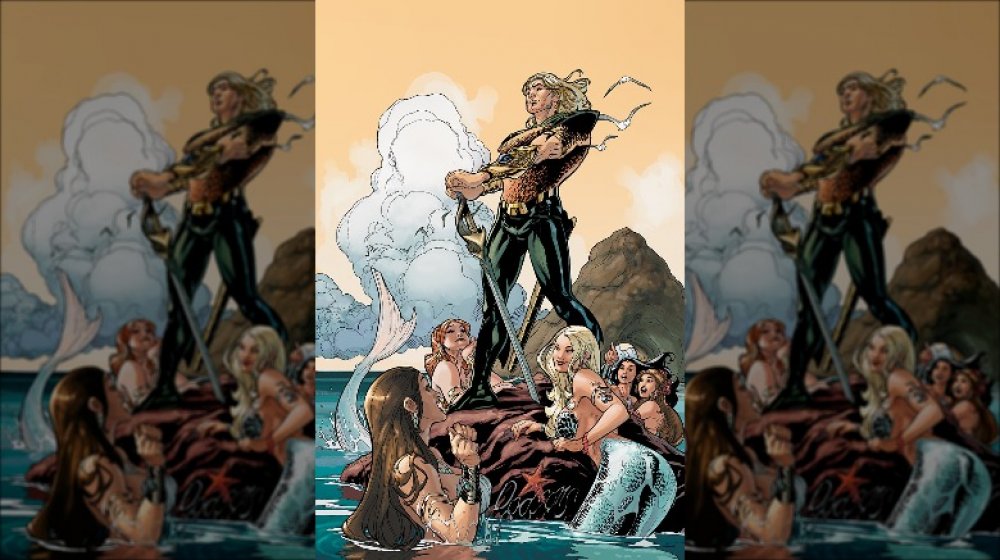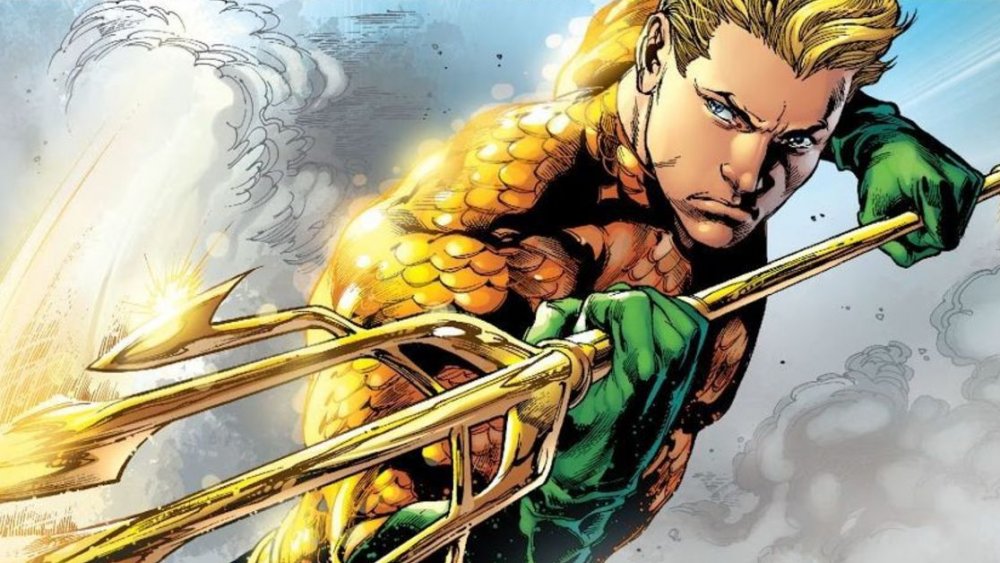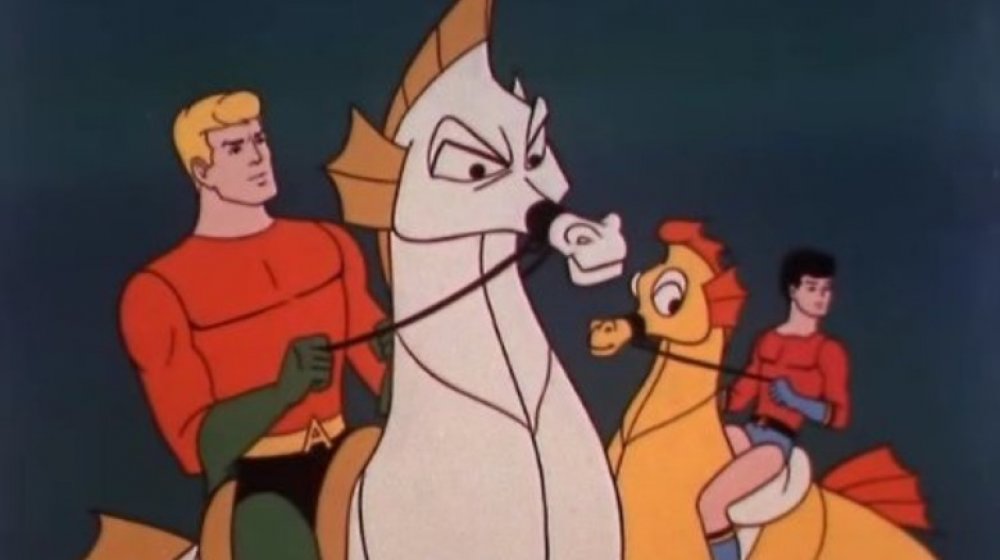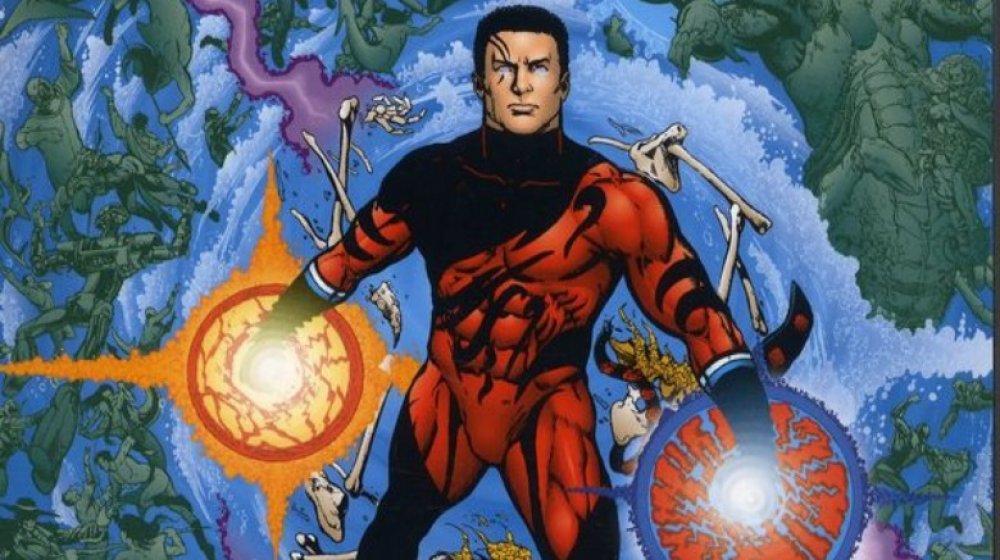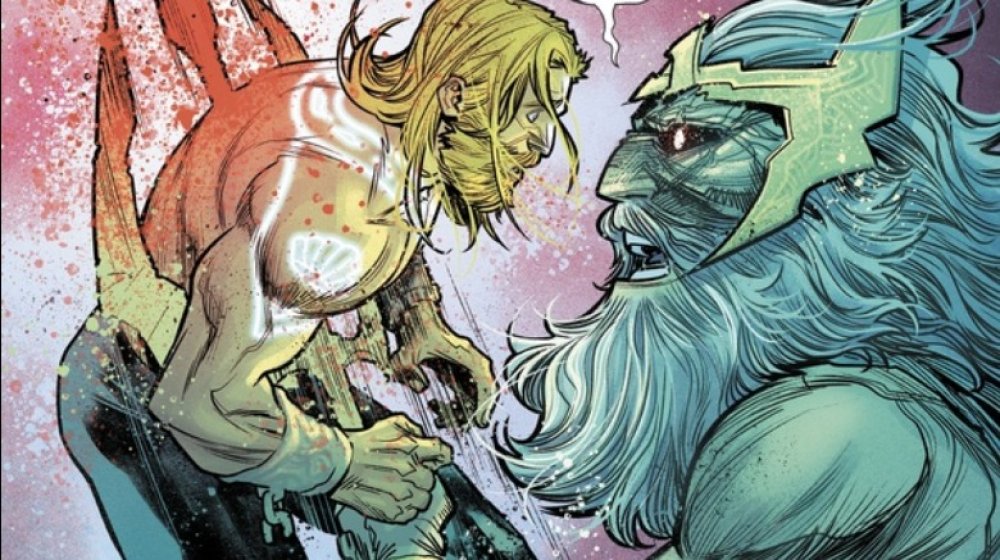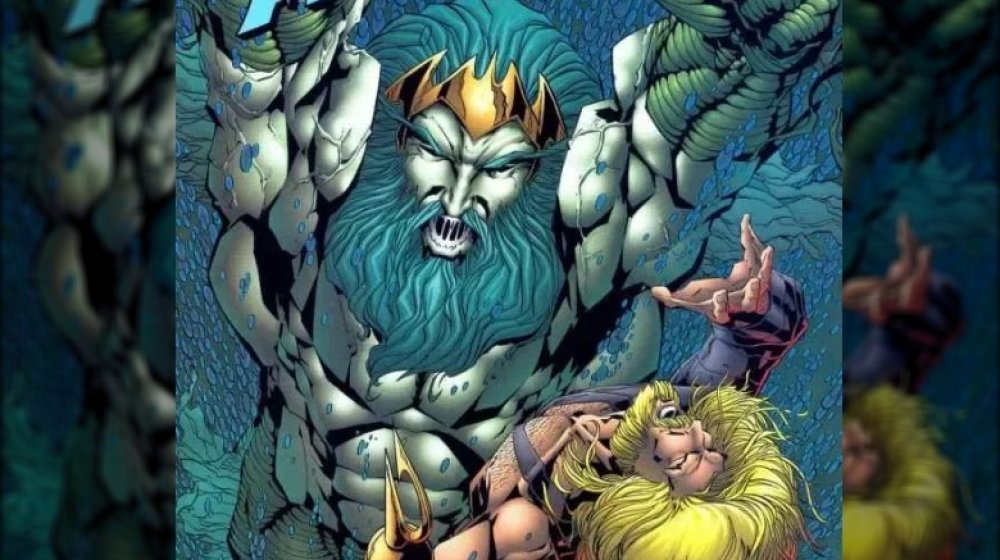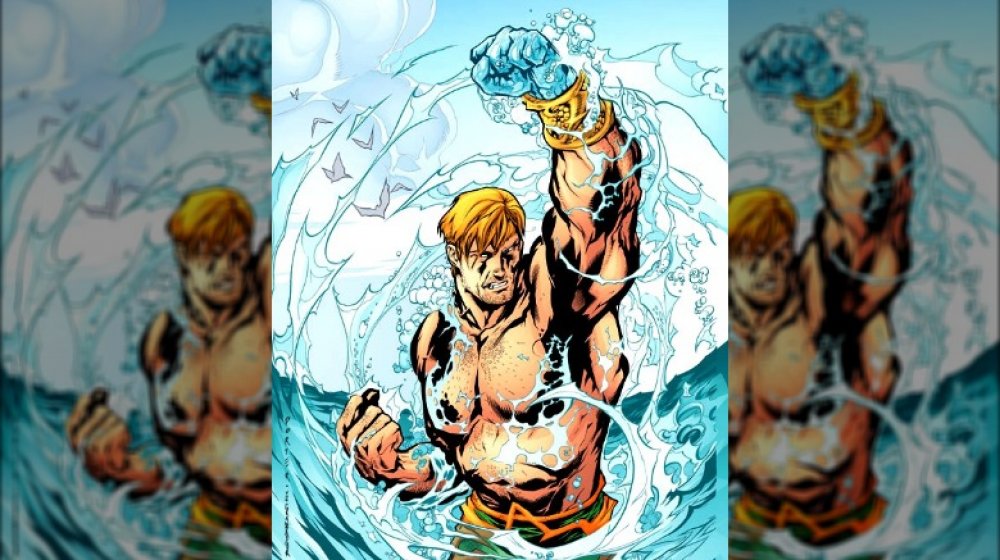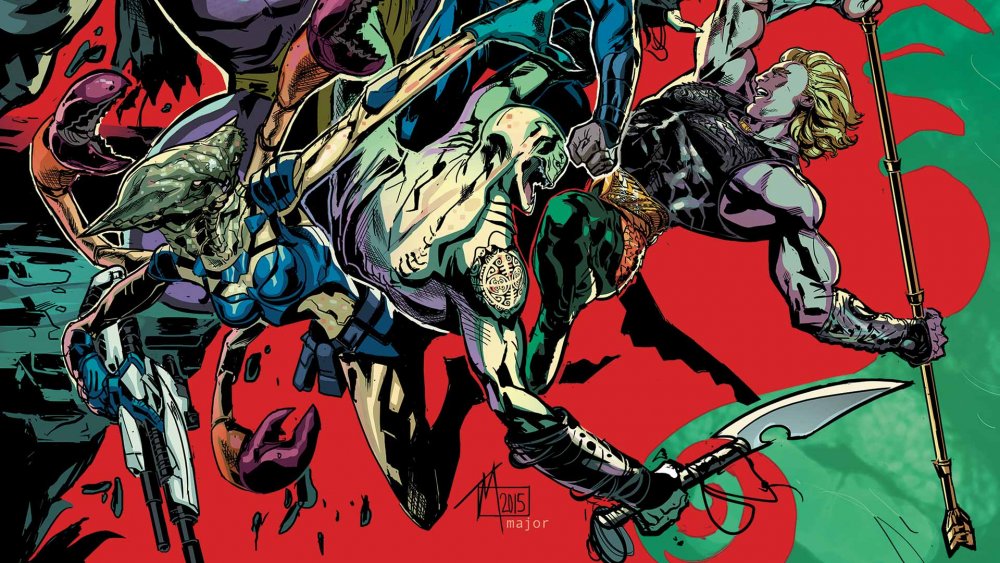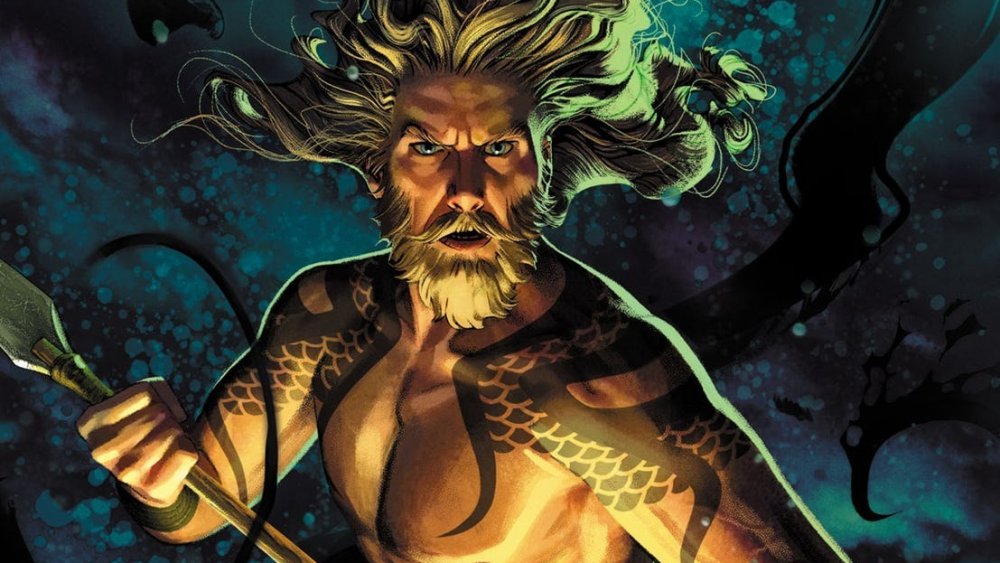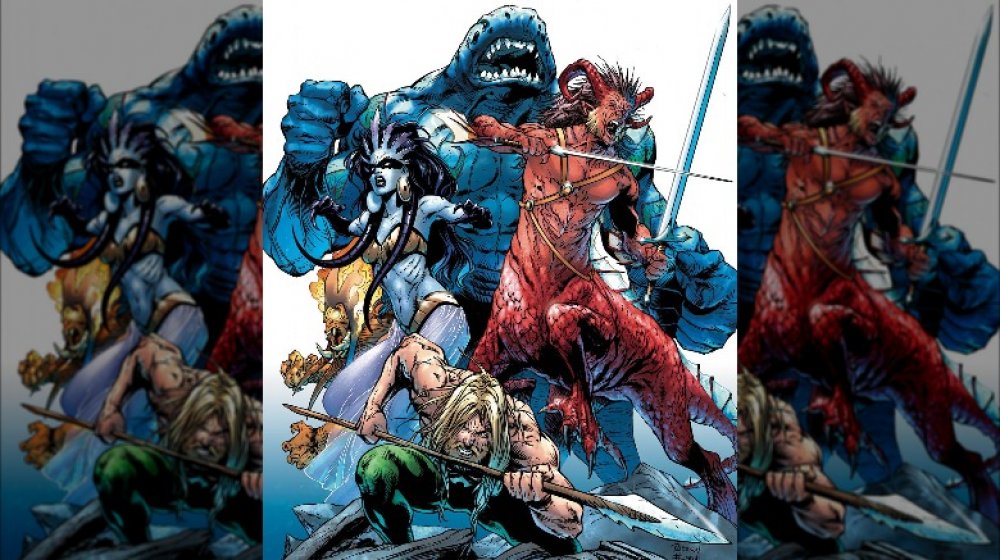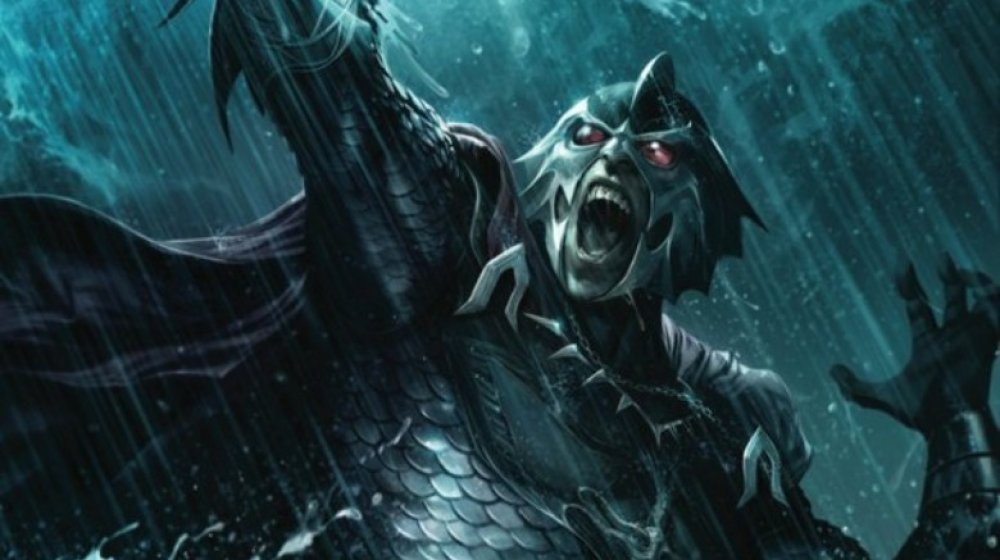The Mythology Behind Aquaman Explained
While Aquaman's earliest adventures from the 1940s primarily deal with him punching pirates and sinking Nazi U-boats with his finny friends, as the years have gone on, Aquaman stories have dug more and more into the various mythological tales of what the seafloor is like from around the world. Tons of elements from Aquaman's world — from mermaids to giant seahorses to sea gods to Atlantis itself — have their roots in authentic myth, legend, and folklore.
Keeping in mind that — as with pretty much every DC Comics character — Aquaman experienced major reworkings of his Whole Deal in the late 1950s, the mid-1980s, and then again in 2011, with minor tweaks along the way (Is he Arthur Curry? Is he Orin? Is he ... both?), here are some of the cooler legends that have crawled their way out of Davy Jones' locker and onto the comics across the years to challenge, help, and/or befriend the one true king of Atlantis, Aquaman!
Atlantis, where Aquaman (sometimes) lives
Since his debut in 1941, Aquaman has been largely defined by his relationship to the lost continent of Atlantis. In the very earliest comics, Aquaman was the son of a famous but unnamed underwater explorer who gave him the ability to breathe underwater and speak to marine life through the secret wisdom of the abandoned kingdom. By 1959, Aquaman was reimagined as the son of a human father and an Atlantean mother and was eventually named the king of Atlantis. Since then, he's been a monarch, an exile, an outcast, a freedom fighter, a prisoner, an outlaw, and pretty much every possible kind of thing he could be vis-a-vis Atlantis. The lost continent is in the bones of the series perhaps more than any other concept.
While concepts of Atlantis have evolved over the centuries, History explains that the idea originated with the philosopher Plato some 2,400 years ago, when he described an advanced and powerful nation that nevertheless sank into the sea, probably intended as a warning against hubris. While Plato likely intended the story as myth or metaphor, the concept has been taken varying degrees of seriously since then, with some people legitimately believing in a sunken continent lost in the North Atlantic. Whether you believe there's anyone still living down there is a whole different question.
Why isn't Aquaman a mermaid?
The various heroes of DC Comics more or less inhabited their own little universes until they started crossing over with each other, most notably starting with 1960's debut of the Justice League of America. Once Aquaman and Superman clearly lived in the same world, the question arose: Why do the inhabitants of Atlantis in the Aquaman comics just look like people, while the Atlanteans in Superman – most notably Clark's college girlfriend, Lori Lemaris — are mermaids? The 1990 series The Atlantis Chronicles answers that question by saying that Atlantis was a continent with multiple major cities, including Poseidonis, where the human-looking Atlanteans lived, and Tritonis, where the inhabitants were transformed by magic into mermaids to better survive the ocean depths after the sinking of Atlantis. So Aquaman himself was a Poseidonian, while Lori Lemaris was a Tritonian. This arrangement has been changed by a number of continuity reboots, but currently, humanoid and non-humanoid Atlanteans live side by side.
Chances are extremely good that you're familiar with mermaids, as there are half-human, half-fish creatures as part of folklore from all over the world, possibly inspired by sightings of marine animals like seals, manatees, walruses, or giant squids. As Encyclopedia Britannica explains, the traditional folkloric mermaid is beautiful and alluring but often dangerous, sometimes offering their love but often luring mortals to their deaths. They also often live 300 years and have no souls, but that's not usually part of Aquaman canon.
Aquaman's giant fork
Except for when Aquaman's hand was a magical shape-shifting harpoon, the weapon most associated with the lord of the seas is the trident. While not always explicitly so, Aquaman's main trident in his role as the true monarch of Atlantis is usually the Trident of Poseidon (sometimes the Trident of Neptune). This three-pronged spear is supposed to be the weapon of the god himself and, as such, possesses multiple powers, including the ability to control the water of the sea, command the weather, blast lightning, or even summon rainbows, if that's a thing you want to do. In the 2011 reimagining of Aquaman's world, the trident was merely one of a set forged by the first king of Atlantis but nevertheless remains immensely powerful.
The original trident of Poseidon from Greek mythology was one of the magical weapons forged for the sons of Cronus by the Cyclopes to aid in their war against the Titans (Zeus, of course, received the thunderbolt, and Hades received a helmet of invisibility). As Theoi explains, the trident was Poseidon's most notable attribute in art and was likely meant to resemble a fishing spear. Even in the original mythology, Poseidon was able to use his trident to cause earthquakes, shatter stone, and summon and command storms at sea. There's nothing about it summoning rainbows, however.
The cooler version of Aquaman's trusty steed
One of the aspects of the Aquaman mythos that was a major part in the older comics and cartoons, but is usually abashedly downplayed in more modern depictions, is Aquaman's numerous named animal friends. Probably the best known is his octopus friend Topo (seen playing the drums in the 2018 Aquaman movie), but he also at various times had a seal friend named Ark, a walrus called Tusky, a dolphin named Porpy, and most recently a golden retriever named Salty. But perhaps his most constant companion throughout the classic era of Aquaman comics and cartoons was his valiant steed Storm, a giant seahorse that he rode like, well, a land horse. Aquaman's sidekick Aqualad had his own mount, a smaller, more playful seahorse named Imp. While a seahorse is likely the most obvious choice for an underwater hero to ride, Storm and Imp have mythological precedent in the form of hippocamps, a somewhat more literal seahorse.
As Theoi explains, hippocamps (from the Greek "hippokampos," meaning "crooked horse") were the preferred rides for the various sea gods of Greek mythology. They were horse up front and fish in the back, like a horsey mermaid, though they frequently also had wings. They were ridden by nereids and tritons, and Poseidon had a chariot pulled by a whole mess of them. To be honest, these are way cooler than big seahorses, and it's weird that the comics don't use them.
You're a wizard, Aqualad
While the most notable thing about Atlantis in Plato's account was its military might, over the centuries, the Atlanteans have come to be thought of as a civilization mighty in both science and magic. In fact, according to the Theosophical Society (so, uh, grain of salt), it was the Atlanteans' magical might that led to their downfall. Theosophical Society founder Madame Blavatsky said that Atlantis was "marked with a character of Sorcery ... The Atlanteans of the later period were renowned for their magic powers and wickedness, their ambition and defiance of the gods." Many other New Age and spiritualist groups and authors have made much of the various wizard powers of Atlantis.
The comics have been no exception, as magic has been a major element in most versions of the Aquaman canon, perhaps most notably in the comics of the 1990s. In that version of events, much of Atlantis' history with magic can be traced back to Arion, the lord high mage of Atlantis before it went underwater. Much is also made of Atlan, the blonde wizard who turns out to be Aquaman's real dad (this is not canon anymore), and the magical abilities gained by Tempest, the sidekick formerly known as Aqualad. While Aquaman's city of Poseidonis focused more on the science side, Tritonis and others of the Lost Cities fostered a more magic-based society.
Poseidon shakes things up for Aquaman
Poseidon is probably one of the best-known Greek gods. He is, after all, the king of some three quarters of the Earth. As Theoi explains, he's the god of the sea, earthquakes, drought, and horses for some reason. Together with his brothers Zeus and Hades, he rules one of the three main realms of human existence, the brothers having cast lots to see who would control what after their victory over the Titans. Like most Greek gods, Poseidon can be somewhat fickle in his loyalties: He helped the Trojans build their city walls, but when they skimped on payment, he sent a sea monster to destroy them. He was subsequently in favor of the Greeks in the Trojan war, but when the Greek warrior Odysseus killed his son Polyphemus, he hounded him for the better part of a decade.
The Poseidon in the Aquaman comics can be similarly unpredictable, though generally adversarial. In an appearance in 1964, Poseidon kidnaps Aquaman's soon-to-be wife, Mera, and only relinquishes her after Aquaman travels through time to conquer him. In the 1990s, Poseidon made Aquaman fight his son Triton for the title of lord of the sea and blinded Aquaman when he won. The god of the sea changes his tune, however, when Aquaman rescues him from Hades, at which point he reluctantly awards Aquaman his trident.
Poseidon's jerk son, Triton
The Greek god Poseidon, in his role as "basically Zeus but wet," naturally has a ton of children by lots of different women who were varying degrees of consenting. His most famous child, however, is probably Triton, who Encyclopedia Britannica explains is the merman son of Poseidon and his wife Amphitrite, whose most famous attribute is his conch shell horn, which he can use to raise and lower ocean levels, such as when Zeus decided to flood the world for its sins. While there is one capital-T Triton who lives with his parents in their golden palace under the sea, lowercase-t tritons were common motifs in mythology and art as basically a race of mischievous underwater satyrs, getting handsy with the water nymphs and what have you.
It's the capital-T Triton who is a major player in the Aquaman comics, however. In the 1990s series, Triton was the big bad of what is more or less the climactic story of that era. Triton challenges Aquaman for the position of lord of the sea, and Aquaman, despite his mortality, manages to deal Triton a fatal blow, after which Poseidon strikes him blind. Poseidon resurrects his son, but feeling the contempt his father holds for him, Triton kills Poseidon and takes his power. Aquaman has to travel to the realm of the dead in order to save the god of the sea and defeat his dangerous son.
A watery tart throws a magic hand at a different King Arthur
While Aquaman is most associated with the oceans and his home of Atlantis, many stories feature him leaving his native kingdom by choice or by force and exploring new ways of being the world's main water person. One such story began in 2003, with Aquaman being exiled from not only Atlantis but the entire ocean and left ashore to dehydrate. Fortunately, Aquaman is rescued by the Lady of the Lake, who gives him access to the Secret Sea, an interdimensional reservoir of healing energy. The Lady of the Lake not only saves his life but replaces the iconic harpoon hand of the 1990s with the less well-known magical water hand that Aquaman bore for most of the 2000s.
The Lady of the Lake is a major, yet mysterious, figure from Arthurian legend. According to the Camelot Project, she is an ambiguous and shifting figure, at times benevolent and at other times dangerous. She's associated with the figures Vivienne and Nimue, and as such, she's not only the one who raises Lancelot and gives Arthur his famous sword Excalibur — she's also the fairy woman who charms and imprisons Merlin and later carries Arthur's body to Avalon. Some consequently suspect there was more than one Lady of the Lake. She has a similarly hard-to-grasp motivation in the Aquaman comics, which touch on Arthurian themes surprisingly rarely for a series literally about a King Arthur.
Atlantis isn't the only lost city in these parts
While Atlantis is by far the most famous lost city to sink beneath the waves (and therefore the one most focused on in Aquaman), it's far from the only legendary city to populate world folklore. One such unknown land is Thule, also known as Ultima Thule ("farthest Thule"), which Mythology.net describes as a mysterious island thought to be at the farthest northern reaches known to the ancient world. The Greek explorer who claimed to have found it described it as a barbaric land full of simple farmers. Also, the sun only set once a year.
In a story from 2015, Aquaman journeys to Thule, which, rather than an Arctic island full of farmers, turns out to be a dimension of sorcerers exiled from Atlantis following a civil war. Aquaman, having been recently deposed from the throne of Atlantis, encounters refugees from Thule and subsequently has to halt an invasion from the wizard dimension.
Other legendary lost cities that have been featured in Aquaman comics include Hy-Brasil, a lost Irish (not South American) island in myth and a city of manta ray people in the comics, and Thierna Na Oge, a fairy world of eternal youth in Irish legend and a land of powerful Atlantean magicians in the comics. Likewise, the comics have made use of the land of Mu, a theoretical (but fictional) sunken continent from the Pacific.
Aquaman's cool tattoos
One of the major visual differences between the classic comics version of Aquaman and the version presented in the DC Extended Universe movies is that the former is a blonde dude in an orange shirt, and the latter is a fully shredded native Hawaiian covered in tattoos. As Aquaman actor Jason Momoa explained to Bustle, these tattoos have an important cultural meaning, including the one that Momoa actually has in real life. The real tattoo is a family crest on his forearm representing a shark's teeth, meant to protect the bearer from sharks by indicating that he is one of their own. The tattoos added for the movie were carefully chosen to reflect various water gods of Polynesian culture, such as Maui, whom you may remember as being pretty inked up himself in Moana. The various designs are meant to evoke armor for protection, as well as spearheads meant to reflect the attack of stingrays.
In 2019, the Aquaman of the comics — who had recently regrown the long hair and beard he sported in the 1990s to look at little closer to Momoa – got his own set of symbolic tattoos that are not an exact copy of the Polynesian tats of the movie but which bear a superficial similarity. These markings aren't even really tattoos: They're a gift from the Old Gods of the Sea as a symbol of Aquaman's heroism.
The forgotten gods of Unspoken Water
In a 2019 story starting in Aquaman #43 by writer Kelly Sue DeConnick and artist Robson Rocha, the former king of Atlantis (look, he loses the throne a lot) washes up on a small island with no memory of who he is or how he got there. This story, called "Unspoken Water," as Think Christian explains, sees the amnesiac Aquaman living among a mysterious and eccentric people from many different cultures. In the end, it turns out these people are, in fact, the Sea Gods of the World, ancient water deities from such cultures as the Aztec, Irish, and Maori, who had been exiled to the island of Unspoken Water for their failure to keep balance in the world's oceans following the battle between the primordial deities Father Sea and Mother Salt.
Since that story, these deities have remained major supporting characters in the Aquaman series, moving with him to his home in Amnesty Bay, and are all based on authentic mythology. Mother Salt, for example, is modeled on Namma, a Babyonian sea goddess, and her daughter Caille, usually depicted in the comic as a blue woman with horns and wings, is based on Cailleach, a Gaelic weather goddess known as the Queen of Winter. The other major characters include Wee, who is really Chalchiuhtlicue, an Aztec storm and sea goddess, and Loc, aka Tlaloc, the Aztec rain god.
Ocean Master's fishiest plan yet
Arguably Aquaman's greatest nemesis is his half-brother Orm, perhaps better known by his rather grandiose nom de guerre Ocean Master. Since his debut in the 1960s, Ocean Master has tried to usurp Arthur's throne, but in a subplot running under the surface since about 2018, he tries his most surprising scheme yet: going legit (maybe?). After seemingly settling down to a peaceful family life on the surface, Orm helps Mera overthrow a pretender to the throne of Atlantis before befriending the young sea goddess Lernaea (her name being a reference to the Greek mythological sea serpent the Hydra) and establishing a refuge for the homeless of Atlantis as well as a number of mutated escaped experiments. He names his new city Dagon, and it seems for all the world that he is planning to lead a coup of Atlantis from it.
The name Dagon is an ancient one and was even used for a one-off Aquaman villain in the 1960s. As Encyclopedia Britannica explains, Dagon was a Semitic fertility god usually depicted with a fish tail. (The name Dagon is related to the Hebrew word for "fish.") As a major god of the Philistines, he appears a number of times in the Bible, including a story from 1 Samuel in which the Ark of the Covenant destroys a statue of him. The ancient deity also inspired the famous H.P. Lovecraft haunted seafloor story "Dagon."
